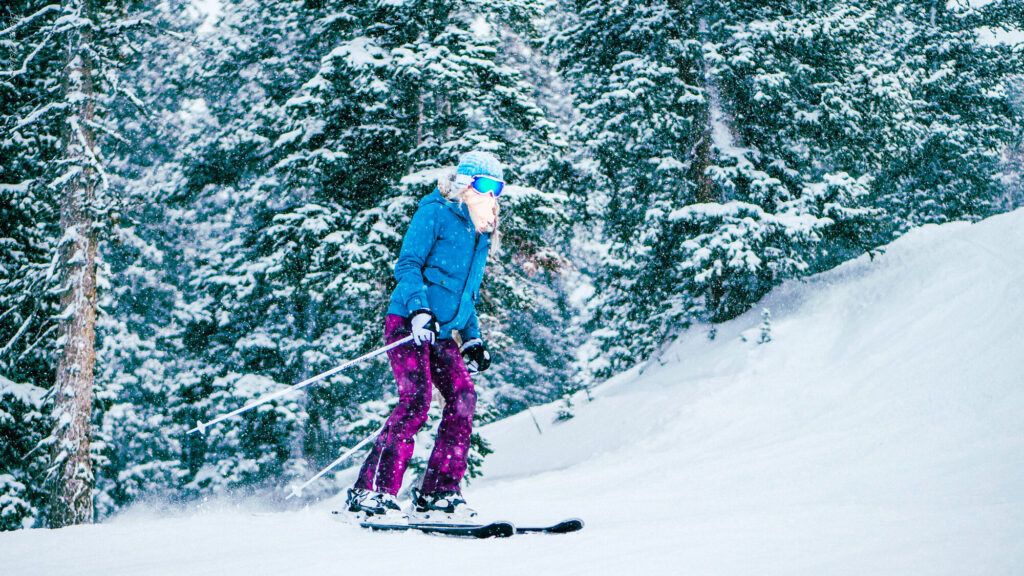
It’s safe to say that we can’t get enough of ski vacations after the pandemic. The 2020-2021 ski season alone saw 59 million ski visits, up from 51 million the year before.
Hoping to join that number for the first time? Skiing for beginners can be exhilarating, but the sport is also demanding and sometimes tricky to get the hang of.
No matter what skiing destinations you have in mind, it’s crucial to make sure you have the right equipment and techniques before you get started. Let’s take a quick look at how to prepare.
Gear Up for Skiing
Before you head out to the slopes, make sure you’ve gotten your hands on the right gear. Though it’s not hard to find equipment online, first-time skiers might want to consider shopping or renting equipment at a brick-and-mortar store, where a pro can ensure that everything you’re getting is the right size. Our Keystone and Copper Mountain locations carry rentals for skiers at every level of expertise, and our trained experts are happy to help fit first-time learners.
Basic Ski Gear for Beginners
There’s a huge range of ski gear on the market, but beginners will need a few basics, at minimum: skis, boots, bindings, goggles, and poles. Helmets are technically optional, but extra protection is always a good idea.
Getting Familiar With Your Skiing Gear
Once you have the right gear, take some time to get to know it. Getting into and out of your ski boots and bindings takes practice, and it’s easier to learn when you’re off the snow. Don’t forget to also practice carrying your skis, which isn’t always as easy as it sounds!
How to Dress for Skiing
If it’s your first time skiing, dressing for success can keep you from getting cold and wet.
Dress in warm layers, but avoid cotton, which is a poor insulator. Opt instead for a sweat-wicking base layer and one or more insulating layers on top. Don’t forget to grab a wind- and waterproof outer shell.
Extra Gear to Pack
Because you’ll be engaging in exercise, it’s important to pack a water bottle to stay hydrated. You’ll also want to use sunscreen, as snow can multiply your UV exposure on sunny days. Though it’s optional, a light ski backpack is a great way to hold all of your extra gear!
Skiing Techniques You Should Know
You may feel ready to start your first run, but you shouldn’t launch into skiing without knowing a few key techniques. There are plenty of tricks to practice, but these basic moves are crucial for beginners:
Proper Ski Stance
When skiing, make sure to stand with your feet around shoulder-width apart with your weight balanced between both feet. The goal is to tilt forward slightly at the ankle, with your shoulders a little bit ahead of your hips. Though it may feel tricky at first, always look at the path ahead rather than at your feet.
Ski Wedges
As you might expect, knowing how to slow and stop is pretty important! You’ll use the wedge technique, also called the “triangle” or “pizza” technique, for this part.
To make a wedge, you’ll move the front tips of your skis closer together, digging the inside edges of the skis into the snow to make a wedge and slow your momentum. A narrower wedge or triangle slows your speed at a gradual pace, while a larger wedge can help you slow down all at once.
Gliding
Beginners should always practice gliding on flat snow. You’ll use your ski poles to push off, pressing your shins against the front of your boots and keeping your body tilted forward as you glide one foot forward after the other.
Walking Uphill
For beginners, “side-stepping” is often the easiest way to get uphill.
To do this, you’ll keep your skis perpendicular to the slope of the hill to keep from sliding down. Lean uphill to press the edges of your skis—the sides closest to the top of the hill—slightly into the snow.
Use the ski that’s closest to the bottom of the hill to push off, and then use the uphill ski to take a step uphill. Bring the downhill ski parallel to the uphill ski, and repeat.
Skiing for Beginners: Bonus Tips
Having a few basic techniques under your belt can help you feel more confident on the slopes, but there are several extra skiing tips worth keeping in mind as you prepare for your first ski day.
Consider Professional Lessons
Skiing is a sport, and it can sometimes be a hard one to pick up, even for an adult. While a few basic techniques can help you feel more comfortable, there’s nothing like an hour-long ski lesson with a pro to push your early skills to the next level. Whether you book a group class or a one-on-one session, a professional can help guide you away from common mistakes beginners make.
Know Your Limits
On that note, know your own limits. Don’t set out on slopes that feel too difficult, regardless of how much fun a friend says they might be: they’re far less exciting when you’re floundering in panic! Be sure to take breaks and to end the day when you start to tire, as fatigue can increase your risk of accidents and falls.
Last, but not least, don’t forget that everyone starts out as a beginner at some point. Stay patient, and keep practicing.
Get More Out of Your First Ski Trip
It should be clear by now that when it comes to skiing for beginners, having the right preparation makes a world of difference.
That’s where we come in!
At Norski Sport Rental, we’re here to offer great gear and service just a short distance from the ski lifts. If you’re just getting started on your ski journey, trust us to provide the gear and insights you need. Contact us with questions or come by to visit today.
